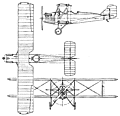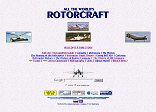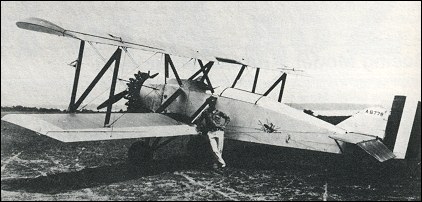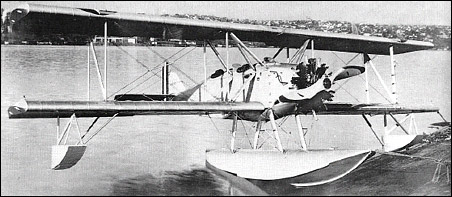|
| Having become recognised as a designer of military aircraft, following the supply of Model 15 to both the US Army (PW-9) and US Navy (FB-1), the company designed the Boeing Model 21 to meet a US Navy requirement for a primary trainer. This was an equal-span biplane, incorporating an unusually wide wing centre-section, and introduced N-type interplane struts to eliminate wing incidence-bracing wires. The divided-axle main units of the tail-skid landing gear had rubber bungee shock absorbers, plus provision for easy conversion to operation with floats. The pilot and pupil were accommodated in tandem open cockpits. Power was provided by a Lawrance J-1 radial engine.
US Navy testing of the Model 21 was carried out with the prototype aircraft, under the designation VNB-1. From the potential operator's point of view, however, the type was unsuitable for the required role, being unspinnable and too easy to fly. On the understanding that modifications would be introduced to make the aircraft a little more demanding, and spinnable, 41 production aircraft were ordered under the designation NB-1. The first of these was delivered on 5 December 1924, and it was soon discovered that Boeing's spin modifications were too effective, since it was possible to get into a flat spin from which recovery was virtually impossible.
Further modifications produced an acceptable compromise. Some NB-1s had Lawrance J-2 or J-4 engines, and several aircraft had 164kW Wright J-5 engines installed at a later date.
Following delivery of the NB-1s an additional 30 were ordered of the NB-2 variant, this differing only by having war-surplus 134kW Wright-Hispano E-4 engines, installed at the US Navy's request to utilise some of the very large number of these licence-built engines held in naval stores.
 | A three-view drawing of NB-2 (844 x 818) |
| MODEL | Boeing Model 21 (NB-1) |
| ENGINE | 1 x 149kW Lawrance J-1 radial piston engine |
| WEIGHTS |
| Take-off weight | 1287 kg | 2837 lb |
| Empty weight | 969 kg | 2136 lb |
| DIMENSIONS |
| Wingspan | 11.23 m | 37 ft 10 in |
| Length | 8.76 m | 29 ft 9 in |
| Height | 3.56 m | 12 ft 8 in |
| Wing area | 31.96 m2 | 344.01 sq ft |
| PERFORMANCE |
| Max. speed | 160 km/h | 99 mph |
| Cruise speed | 145 km/h | 90 mph |
| Ceiling | 3110 m | 10200 ft |
| Range | 483 km | 300 miles |
| ARMAMENT | 1 x 7.62mm machine-gun |
| Lynn Whitfield, e-mail, 29.08.2025 03:39 After losing $156,60 to a scam, I spent three years searching for help. Brunoe Quick Hack came through when no one else could. They recovered my funds and gave me hope again. I highly recommend their service to any scam victim. Email. BrunoeQuickHACK(AT)gmail. COM....
WhatsAPP +17057842635....
ÔÇ"Lynn Whitfield, Los Angeles reply | | Jerzy Bosz, e-mail, 17.08.2025 21:14 Pilna darmowa oferta po┼╝yczki
Szukasz pomocy finansowej na rozs─ůdnych warunkach i potrzebujesz pieni─Ödzy na konto bankowe w ci─ůgu 24 godzin? Jeste┼Ť pracownikiem lub osob─ů samozatrudnion─ů, a bank odrzuci┼é Tw├│j wniosek? Chcesz sp┼éaci─ç stare zad┼éu┼╝enie, ale nie masz zabezpieczenia? W ka┼╝dym razie mog─Ö po┼╝yczy─ç Ci dowoln─ů kwot─Ö z Twoich dochod├│w. Zapytaj o atrakcyjne finansowanie pozabankowe na korzystnych warunkach od 3% oprocentowania miesi─Öcznie, kontakt >>> jerzyboszczar20@gmail.com reply | | John Wilson, e-mail, 13.08.2025 17:55 It feels good when you know you have a great credit profile. I was dying slowly inside until I opened up my situation to a colleague┬á who then recommended Jerry Link Credit Group, and narrated how they increased his score. I immediately contacted via:┬ájerrylinkgroup@gmail.com, I made some financial commitment upfront. Days after, all the negative on report cleared, bankruptcy was removed completely, including foreclosure, and my score was raised to 789. I promised to let others know about their services. Do reach out to them via email. Thanks┬á reply | | Frank Donovan, e-mail, 24.01.2024 06:18 I am so happy to have consulted RAPID RESCORE CREDIT for my credit repairs. I discovered that I had 5 negative items on my credit most especially IRS, delayed payments and loans and over 7 hard inquiries from every bureaus and it hindered me from moving forward in my business. I could not access any loan so I started looking for ways to salvage my condition, I then discovered this specialist (RAPID RESCORE CREDIT) on reddit though there were other ones there but my instinct directed me towards Mr Jackson. I was asked for funds to get started with the job and I gave them the benefit of doubt and made some commitments. My fico score was moved from 609 to an excellent score (799) and all the negatives were deleted from my report. Right now I have a clean profile with wonderful trade lines. IÔÇÖm recommending their services to anyone in dire need of credit fix, you can reach them via JACKSONRAPIDCREDITSCORE@GMAIL.COM reply | |
| | Patrick Burnside, e-mail, 13.01.2024 01:06 Here's how I raised my FICO score from 430 to 785. My diabetic condition caused me to fall behind on my medical bills, which caused my world to fall apart. I searched high and low for someone who could help me repair my credit, but to no avail. In November of last year, I met JERRYLINK CREDIT GROUP through a friend they had worked for; they restored my dignity and boosted my credit in 9 days, allowing me to take out a loan and pay for a house. You can reach them at JERRYLINKGROUP@GMAIL.COM or via TEXT at +1 626 514 0620 reply | | Morgan Kennedy, 10.12.2023 08:22 Mr. Jerry and I have worked together for many years now in a professional setting. I am a realtor and have clients in various stages of credit repair. Mr. Jerry is ALWAYS the person I recommend to my clients. His services are second to none & he has always done the best job in order to get my clients in a home as quick as possible when credit is holding them back. He has helped my family members, friends, & strangers I have met through my services. Thank you Mr. Jerry for caring about people like you do! You are making a difference!!! Reach out to Jerrylink Credit Group via: jerrylinkgroup@gmail.com or text 6265140620. Thank me later. reply | | Grace Peterson, e-mail, 02.12.2023 03:54 I strongly JERRYLINK CREDIT GROUP: I think they are the best in terms of credit repair. I had worked with different credit companies in the past, but there was no significant change on my credit report. So many credit forums recommended DYI, I tried every credit hack in the book all o no avail. A real estate agent introduced me to Mr. Jerry, who has been helping his clients. Mr. Jerry and his team helped me erase all the negative things on my report, and raised my score to excellent score across all three bureaus. IÔÇÖm recommending as promised. They are available on gmail: JERRYLINKGROUP AT GMAIL DOT COM or +16265140620 reply | | Leon Cody Garcia, e-mail, 28.11.2023 23:00 We will fix your credit; remove all negative items, clear loans, collections and hard inquiries and also raise your score to 760+ ASAP. These were the exact words from M. Jerry when I contacted him via JERRYLINKGROUP at GMAIL dot COM. I decided to give JERRYLINK CREDIT GROUP a try and to my greatest surprise it worked out for me. In less than 11days after all documentation; my score drastically increased to 810 across the three national credit bureaus (Equifax, Experian and TransUnion), I could no longer sight evidence of collections, negative marks, mortgage loan, collections and hard inquiries on my credit report. I honestly appreciate Mr. Jerry for fixing my credit. reply | | James Peet, e-mail, 18.11.2022 04:08 My grandfather died in 1924 when an NB-1 he was testing went into a tailspin at an altitude that was too low to make recovery impossible. The belief has always been that he deliberately went into the tailspin due to mis-judging his altitude. (1,000 ft). What would the chances have been that the NB-1 could have had a problem that would have resulted in the plane stalling? reply |
|
Do you have any comments?
|
| 
COMPANY
PROFILE
All the World's Rotorcraft
|









20
reply